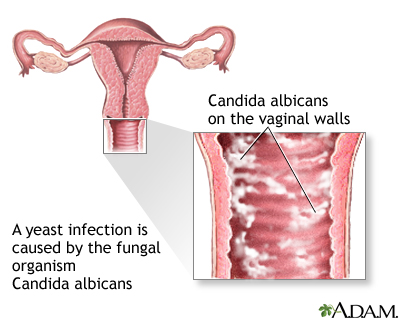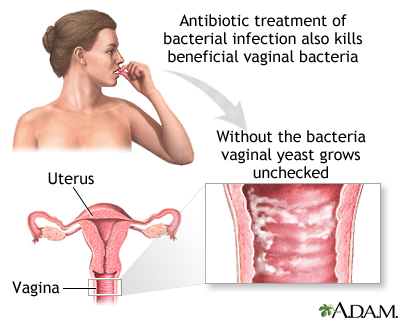Definition of Vaginal yeast infection
Vaginal yeast infection is an infection of the vagina, most commonly due to the fungus Candida albicans.
Alternative Names for Vaginal yeast infection
Yeast infection - vagina; Vaginal candidiasis; Monilial vaginitis
Causes, incidence, and risk factors
Most women will have a vaginal yeast infection at some time. Candida albicans is a common type of fungus. It is often present in small amounts in the vagina, mouth, digestive tract, and on the skin. Usually it does not cause disease or symptoms.
Candida and the many other germs or microorganisms that normally live in the vagina keep each other in balance. However, when the vagina has certain favorable conditions, the number of Candida albicans increases, leading to a yeast infection.
Some of these favorable conditions include:
- Antibiotics used to treat other types of infections change the normal balance between organisms in the vagina by decreasing the number of protective bacteria.
- Being pregnant, having diabetes, or being obese all create conditions that help yeast grow more easily.
Vaginal candidiasis is not a sexually transmitted disease. However, a small number of men will develop symptoms such as itching and a rash on the penis after having sexual contact with an infected partner.
Having many vaginal yeast infections may be a sign of other health problems. Other vaginal infections and discharges can be mistaken for a vaginal yeast infection.
Repeat infections that occur immediately after treatment, or a yeast infection that does not respond to any treatment, may be an early sign that a person is infected with HIV.
Symptoms of Vaginal yeast infection
- Abnormal vaginal discharge
- Ranges from a slightly watery, white discharge to a thick, white, chunky discharge (like cottage cheese)
- Pain with intercourse
- Painful urination
- Redness and swelling of the vulva
- Vaginal and labial itching, burning
Signs and tests
A pelvic examination will be done. It may show swelling (inflammation) of the skin of the vulva, in the vagina, and on the cervix. The health care provider may find dry, white plaques on the vaginal wall.
A small amount of the vaginal discharge is examined using a microscope (called a wet mountand KOH test). It will show Candida.
Sometimes, a culture is taken when the infection does not improve with treatment or comes back many times.
Your doctor may also choose to do tests to find other causes of your symptoms.
Treatment of Vaginal yeast infection
Medications for vaginal yeast infections are available in either vaginal creams or suppositories. Most can be bought without a prescription.
Treating yourself at home is probably okay if:
- Your symptoms are mild and you do not have pelvic pain or a fever
- This is not your first yeast infection and you have not had many yeast infections in the past
- You are not pregnant
- You are not worried about other sexually transmitted diseases from recent sexual contact
If your symptoms do not get better after one course of these medicines, or they become worse, see your health care provider. If your symptoms go away, but then return over the next several weeks or months, also see your health care provider.
Medications you can buy yourself to treat a vaginal yeast infection are miconazole, clotrimazole, tioconazole, and butoconazole. Read the packages carefully and use them as directed. Do not stop using these medications early because your symptoms are better. You will need a 3 - 7-day course, depending on which medicine you buy.
A single pill of a medicine called fluconazole, prescribed by your doctor or nurse, can also treat the yeast infection.
If your symptoms are more severe or you have repeat vaginal yeast infections, you may need to take a longer course of therapy, up to 14 days.
Some women who continue to have repeat infections may need to take a clotrimazole vaginal suppository or one oral dose of fluconazole every week to prevent new infections.
To help prevent and treat vaginal discharge:
- Keep your genital area clean and dry. Avoid soap and rinse with water only. Sitting in a warm, but not hot bath may help your symptoms.
- Avoid douching. Although many women feel cleaner if they douche after menstruation or intercourse, it may actually worsen vaginal discharge because it removes healthy bacteria lining the vagina that protect against infection.
- Eat yogurt with live cultures or take Lactobacillus acidophilus tablets when you are on antibiotics to prevent a yeast infection.
- Use condoms to avoid catching or spreading sexually transmitted diseases.
- Avoid using feminine hygiene sprays, fragrances, or powders in the genital area.
- Avoid wearing extremely tight-fitting pants or shorts, which may cause irritation.
- Wear cotton underwear or cotton-crotch pantyhose. Avoid underwear made of silk or nylon, because these materials are not very absorbant and restrict air flow. This can increase sweating in the genital area, which can cause irritation.
- Use pads and not tampons.
- Keep your blood sugar levels under good control if you have diabetes.
Support Groups for Vaginal yeast infection
Expectations (prognosis) for Vaginal yeast infection
The symptoms usually disappear completely with adequate treatment.
Complications of Vaginal yeast infection
Chronic or recurrent infections may occur if you do not get the proper treatment, you reinfect yourself, or you have an underlying medical condition.
Secondary infection may occur. Intense or prolonged scratching may cause the skin of thevulva to become cracked and raw, making it more likely to get infected.
Calling your health care provider
Call for an appointment with your health care provider if:
- This is the first time that you have had symptoms of a vaginal yeast infection
- You are unsure of whether you have a yeast infection (if you are sure that you have a yeast infection, you can treat the disorder with over-the-counter medications)
- Your symptoms don't go away after using self-treatment vaginal creams
- You develop other symptoms
Prevention of Vaginal yeast infection
Avoid persistent and excessive moisture in the genital area by wearing underwear or pantyhose with cotton crotches, and loose-fitting slacks. Avoid wearing wet bathing suits or exercise clothing for long periods of time, and wash them after each use.
Yeast infections
Yeast infections may follow a course of antibiotics that were prescribed for another purpose. The antibiotics change the normal "balance" between organisms in the vagina by suppressing the growth of protective bacteria that normally have an antifungal effect.

Secondary infection
Secondary infection occurs during or after treatment of a primary infection because the normal bacterial flora is destroyed, allowing yeast to flourish.

Feel Free To Leave Comments To My Posts,Its Always Nice To Get Feed Back!:)
No comments:
Post a Comment